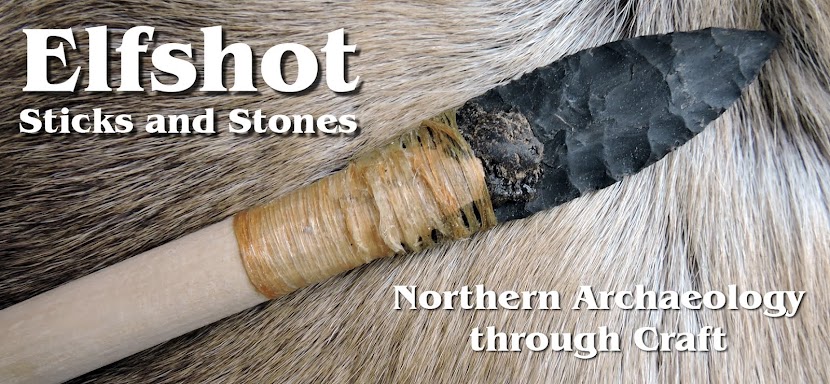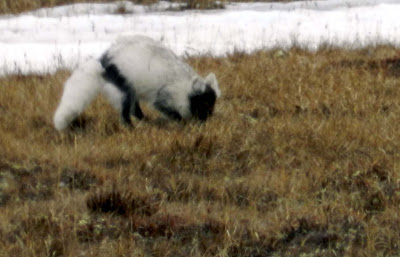 |
| Fox Skull |
Wednesday, June 29, 2011
Monday, June 27, 2011
We Are... Archaeologists
About a year ago I was contacted by someone assembling a marketing campaign to promote careers with the Newfoundland and Labrador Government. They asked to use a photo of some of my harpoon reproductions to help illustrate a career in Archaeology. The campaign is now online, you can check it out here:
Photo Credit: Screen grab from http://www.gov.nl.ca/WeAre/archaeologist.html#
Photo Credit: Screen grab from http://www.gov.nl.ca/WeAre/archaeologist.html#
Friday, June 24, 2011
Photo Patterns
Wednesday, June 22, 2011
Soapstone Polar Bears
 |
| I made all these little soapstone bears for The Rooms. They are included in education kits sent to classrooms around the Province. |
 |
| This is the original artifact that they are all based on. Its a Dorset Palaeoeskimo artifact from northern Labrador. You can see it on display in the Connections Gallery in The Rooms in St. John's. |
 |
| The 20 little bears were just the right size to be delivered in an egg carton. |
 |
| All of the soapstone that I used for the bears came from highway roadcuts on Newfoundland's Baie Verte Peninsula. |
 |
| Did they all catch the sent of something? I would not want to be downwind of this many curious bears. |
 |
| I don't think I realized it when I carved them, but with his nose lifted and his mouth open, the posture of the little Dorset bear looks like a bear sniffing the air. |
Labels:
Labrador,
Polar Bears,
Portfolio,
Reproductions,
Soapstone,
The Rooms
Monday, June 20, 2011
Recent Indian Reproductions
 |
| I found these pictures on my hard drive from 2006. They are a Recent Indian knife and scraper reproduction. I can't recall who the client was, but I think it was either The Rooms or the Province. |
 |
| In both tools, the stone blade is held in the wood handle with hide glue and rawhide. Each piece is covered in Red Ochre. |
Labels:
Knives,
Portfolio,
Recent Indian,
Red Ochre,
Reproductions,
Scrapers
Friday, June 17, 2011
Father's Day
 |
| My Dad as a boy |
 |
| Dad, An Indian Motorcycle and Tiny Dog |
He raised them as pets, but had to keep them chained up in the yard because they couldn't be trusted around the chickens. They didn't like sleeping above ground, instead they dug a hole in the yard and slept down there. Judging from these photos they were very tame. Unfortunately one of the pups got strangled up in the chain going down into its den and didn't get a chance to grow up. The second pup grew up and was a loyal friend to my dad. Eventually it earned a little bit of trust and was allowed to spend time off leash.
But the leash was for its own protection as much as the other farm animals. There was a bounty on coyotes at the time, with the Province paying $2 for a pair of dead coyote ears. It was a dangerous time to be a coyote in southern Saskatchewan. In the dark, in the truck, my dad told me about the day his pet coyote was running and playing in the prairie just south of his parent's farm. A car drove by the farm and past the coyote. Dad watched the car with some concern. It slowed, stopped, and starting backing up when the driver spotted the coyote. Without any fear of people, the coyote stood and watched the car approach. My dad knew about the bounty and ran to his bicycle and started peddling down the road, bawling and yelling at the driver to stop, but he was too late. The driver shot his coyote.
 |
| My Dad with two of his 7 siblings |
But then Dad bounced back and said; "I got two bucks for the ears, though!"
Happy Father's Day!
(Lori said this story was too sad for a Father's day post, but I mailed a printed version of this post to my dad and we talked about it on the phone. He couldn't remember the whole episode, but when I reminded him about it, he was still pretty impressed that the guy in the car gave him the ears. I think he's had time to get over it.)
Photo Credits: Rast Family Photos
Wednesday, June 15, 2011
Cool Canadian Lithic Blogs
This is my first pre-scheduled blog post of the summer. Here are a couple of fascinating blogs that I enjoy following and that you might like as well.
PaleoNick: Musings from a man behind the times. Way behind. Nick Waber is an archaeology Grad student at the University of Victoria, in British Columbia who specializes in lithic technology and experimental archaeology. In the first few posts on his new blog he documents some of his experiments with hafting microblades and testing their performance in ballistic's gel experiments. Plus, he's into minimalist running.
PaleoNick: Musings from a man behind the times. Way behind. Nick Waber is an archaeology Grad student at the University of Victoria, in British Columbia who specializes in lithic technology and experimental archaeology. In the first few posts on his new blog he documents some of his experiments with hafting microblades and testing their performance in ballistic's gel experiments. Plus, he's into minimalist running.
Stoneflake: Paul Dolanjski posts stunning photographs of wildlife, flintknapping, and bushcraft on Stoneflake.net. The site describes itself this way: "Stoneflake.net is a mis-mash of information pertaining to Prehistory, Geology and skills of the past. It is an ongoing project with new material being added weekly." Flip through some of the older posts - the posts won't weigh you down with text, but the photography leaves a lasting impression.
Photo Credits: Screen captures from the respective sites.
Monday, June 13, 2011
Another Summer, Another Pile of Gear on the Floor
I leave for the field tomorrow. Of course, the day after my flight was booked, Air Canada employees served 72 hour strike notice to walk out 16 hours before I'm scheduled to fly out of St. John's. Canada Post started rotating strikes across the country in the last weeks that I was trying to wrap up and ship the final Elfshot orders of the spring, so a strike from Air Canada seems like an appropriate way to kick-off the field season. I wonder what the chances are that the mosquitoes won't show up for work in July?
Wednesday is my first pre-scheduled post of the summer. I'll poke my head in from time to time and let you know how the summer is going.
Take care,
Tim
Photo Credits: Tim Rast
Wednesday is my first pre-scheduled post of the summer. I'll poke my head in from time to time and let you know how the summer is going.
Take care,
Tim
Photo Credits: Tim Rast
Friday, June 10, 2011
Rhyolite Jewelry and Changing Seasons
I finished off one last wholesale order this week. These rhyolite necklaces, earrings, and reproduction Beothuk arrow will be available for purchase in the gift shop in the Burnside Archaeology Centre this summer. These are the last pieces to come out of the workshop for several months. I'm really going to miss the studio, but its time to head North and get re-invigourated by cool air and 24 hours of sunlight.
I'm leaving next Tuesday for archaeological fieldwork in Nunavut. I will be back in St. John's for a week or two later in the summer, but I really won't be home again until September. I'm closing up the Elfshot workshop for the season right now. This summmer, I'm holding one of the permits on the project, which means a little more responsibility in the field and a lot more follow-up work and report writing in the fall. I'm afraid I won't have much time to devote to Elfshot again until the winter.
I'll share what I can from the field throughout the summer and I've set up a bunch of pre-scheduled posts to try to keep the Monday, Wednesday, and Friday posting schedule uninterupted for the days that I don't have internet access or when work gets too hectic.
Photo Credits: Tim Rast
I'm leaving next Tuesday for archaeological fieldwork in Nunavut. I will be back in St. John's for a week or two later in the summer, but I really won't be home again until September. I'm closing up the Elfshot workshop for the season right now. This summmer, I'm holding one of the permits on the project, which means a little more responsibility in the field and a lot more follow-up work and report writing in the fall. I'm afraid I won't have much time to devote to Elfshot again until the winter.
I'll share what I can from the field throughout the summer and I've set up a bunch of pre-scheduled posts to try to keep the Monday, Wednesday, and Friday posting schedule uninterupted for the days that I don't have internet access or when work gets too hectic.
Photo Credits: Tim Rast
Wednesday, June 8, 2011
Clovis Spear
 |
| Point and Foreshaft |
 |
| Complete spear, with red ochre staining. Over 7' 1" long |
 |
| More robust than the Archaic |
 |
| 38cm long foreshaft |
 |
| The foreshaft could be used as a knife |
 |
| Gut and glue drying |
 |
| The flattened foreshaft fits into a rawhide reinforced socket on the mainshaft. |
 |
| Staining the mainshaft |
Photo Credits: Tim Rast
Monday, June 6, 2011
Whalebone Whatzit
 |
| What is this thing |
 |
| Reproduction Palaeoeskimo Whalebone object - 34.5 cm long |
 |
| The underside is incised porous bone |
 |
| Rib and my printed patterns of the artifact |
 |
| Throat grooves |
 |
| Originally it had a hole |
 |
| When it was found the hole through the bear head was broke open (reproduction shown) |
 |
| The pointy end is blunted |
 |
| Bear head and lateral hole |
 |
| The underside showing the offset hole and the long incized grooves running back from the head. |
Photo Credits: Tim Rast
Friday, June 3, 2011
Clovis Point
 |
| Clovis Point made from Novaculite |
 |
| It will be hafted and ochre stained |
 |
| Looking up from the base |
 |
| The mostly complete channel flake in place |
 |
| The 1st flute did not completely separate |
 |
| Great design for hafting |
Photo Credits: Tim Rast
Subscribe to:
Posts (Atom)
















